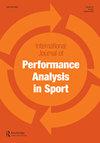Introducing the technical individual contribution coefficient: a metric for evaluating performance in elite volleyball
IF 1.6
4区 教育学
Q2 SPORT SCIENCES
International Journal of Performance Analysis in Sport
Pub Date : 2023-11-11
DOI:10.1080/24748668.2023.2278380
引用次数: 0
Abstract
ABSTRACTThis study introduces a new metric, the Technical Individual Contribution Coefficient, that enables the quantification of the individual technical performance in elite volleyball, from the practical perspective of coaches. Additionally, three Relative Individual Contribution Coefficients provide complimentary information on the players’ relative participation. Data from 20 matches of eight teams during the 2019 Club World Championship were provided by Data Volley software. The numerical evaluation of the players’ actions was based on experts’ ratings, and all calculations were carried out using Python programming. Binomial logistic regression and the areas calculated under the receiver operating characteristic curves were utilised to predict set outcomes based on team variables. For individual analysis, Spearman’s rho correlations and multiple descriptive analyses were conducted, and dynamic visualisations in Power BI were employed to enhance interpretation. The proposed coefficients efficiently predict both absolute and relative technical performance, across all game actions. This novel metric offers a comprehensive tool for performance evaluation and has significant potential to benefit not only fans and the media, but also coaches and team managers in their decision-making process for player selection. The dynamic visualisations utilised make it easier to understand multiple comparisons and to identify ways for improving performance.KEYWORDS: Sport analyticsvolleyballteam sportindividual assessmentdata analysispython programming Disclosure statementNo potential conflict of interest was reported by the author(s).Author contributionsDesign: All authors contributed. Methodology: M.Z and C.L.S. Data collection: C.L.S. Data analyses: M.Z and C.L.S. JJ.M.M, C.L.S, and M.Z drafted the manuscript and all the authors edited and revised the manuscript. All the authors approved the final version.Data availability statementThe data that support the findings of this study are openly available in figshare at doi.org/10.6084/m9.figshare.22189657介绍了技术个人贡献系数——一种评价优秀排球比赛成绩的指标
摘要本文从教练员的角度出发,引入了一种新的指标——技术个人贡献系数,对精英排球运动员的个人技术成绩进行量化。此外,三个相对个人贡献系数提供了关于玩家相对参与的补充信息。2019年世界俱乐部锦标赛期间,8支球队的20场比赛数据由Data Volley软件提供。玩家行动的数值评估是基于专家的评级,所有的计算都是使用Python编程进行的。利用二项逻辑回归和在接收者工作特征曲线下计算的面积来预测基于团队变量的集合结果。对于个体分析,进行了Spearman 's rho相关和多重描述性分析,并使用Power BI中的动态可视化来增强解释。提议的系数有效地预测了所有游戏动作的绝对和相对技术性能。这个新颖的指标提供了一个全面的表现评估工具,不仅对球迷和媒体有很大的好处,而且对教练和球队经理在球员选择的决策过程中也有很大的好处。所使用的动态可视化可以更容易地理解多个比较,并确定改进性能的方法。关键词:体育分析;排球队运动;个人评估;数据分析;python编程;设计:所有作者均有贡献。数据收集:C.L.S.数据分析:m.z.和C.L.S. j.j.m.。M、C.L.S、M.Z共同起草了稿件,所有作者对稿件进行了编辑和修改。所有作者都认可了最终版本。数据可用性声明支持本研究结果的数据可在doi.org/10.6084/m9.figshare.22189657上公开获取
本文章由计算机程序翻译,如有差异,请以英文原文为准。
求助全文
约1分钟内获得全文
求助全文
来源期刊

International Journal of Performance Analysis in Sport
Health Professions-Physical Therapy, Sports Therapy and Rehabilitation
CiteScore
4.40
自引率
4.80%
发文量
38
期刊介绍:
The International Journal of Performance Analysis in Sport aims to present current original research into sports performance. In so doing, the journal contributes to our general knowledge of sports performance making findings available to a wide audience of academics and practitioners.
 求助内容:
求助内容: 应助结果提醒方式:
应助结果提醒方式:


